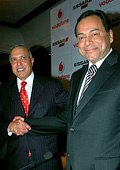 |
| Perfect bonding: Vodafone's Arun Sarin
(left) with Essar's Ravi Ruia |
In
mid-2005, Rajeev Chandrasekhar sold BPL Communications to Essar
Teleholdings for Rs 4,400 crore, and signalled the dawn of the
billion-dollar M&A era in the Indian telecom space. His operations,
spread across four circles, including the lucrative Mumbai circle,
then had a subscriber base of 2.63 million. This was only the
beginning. More such deals followed. In October 2005, Vodafone
picked up a 10 per cent stake in Bharti Airtel for $1.5 billion
(then Rs 6,750 crore); then, in December 2005, Maxis Communications
of Malaysia and the Reddys of Apollo Hospitals bought out C. Sivasankaran's
100 per cent stake in Aircel for $1.08 billion (then Rs 4,860
crore); and in April 2006, the Aditya Birla Group acquired the
Tata Group's 48.14 per cent holding in Idea Cellular for Rs 4,406
crore. The mother of all telecom deals in India, of course, was
Vodafone's 52 per cent buyout of Hutchison Essar for $10.9-billion
(Rs 44,690 crore) last year, that valued the company at $21 billion
(Rs 86,100 crore). It's almost as if the law of gravity had been
put in suspended animation-what went up could only go higher in
the Indian telecom space, it seemed.
There were (and are) sound economic reasons
for the exponential growth in the valuations of Indian telcos.
"Two years ago, one couldn't have anticipated a monthly subscriber
growth of six million new additions," says Rajeev Gupta,
Managing Director and Head of the Carlyle India Buyout Team. Then,
India's wireless subscriber base of 167 million at the end of
April 2007 translates to a penetration level of less than 16 per
cent. For China, a comparable market, the figure has already crossed
400 million, a penetration of 35 per cent.
Clearly, then, the Indian market has massive
headroom to grow. It is this potential that excites global giants
like Vodafone and others that now view India as a long-term play.
The natural corollary: they are willing to pay high premiums to
grab a slice of this pie. "India is a compelling telecom
story; no wonder all serious players want to be a part of it,"
says Manisha Girotra, Managing Director and Chairperson (India),
UBS Securities. Her firm represented Vodafone in its buyout of
Hutch-Essar.
|
THE VALUATION CONUNDRUM
A number of imponderables could impact
the value of telecom companies.
|
|
»
The subscriber story
is looking big today since penetration levels are low. However,
Average Revenue Per User (ARPU) is falling, from Rs 370
for Oct.-Dec. 2005 to Rs 315.93 for Oct.-Dec. 2006. Going
forward, this is certain to impact valuations.
»
For now, though, the number of
potential buyers is much greater than the number of possible
sellers. Given this lopsided demand-supply equation, valuations
could remain high for some time.
»
The availability of spectrum
could be an issue, given that operators are keen on not
only expanding their current operations but also targeting
3G services. This issue will be critical over time and could
have a negative effect on valuations.
|
Many Buyers, Few Sellers
A decade ago, there were a large number of
players to choose from. Today, following several rounds of consolidation-which
saw the exit of players like JTM, RPG, Usha Martin, Skycell and
Telstra-there are five large private operators, Bharti Airtel,
Reliance Communications, Hutchison Essar, Tata Teleservices and
Idea and the public sector bsnl that have largely carved out the
market among themselves. The implication: buyers who want to enter
the Indian telecom sector at this stage have to buy a large operator;
this will naturally involve the payment of a hefty control premium.
The Vodafone-Hutch deal is a case in point. "Valuations are
about projections of future cash flows discounted to their present
value. Earlier, the subscriber base was the key determinant of
valuation since EBITDA figures of most players were largely in
the negative," says Sanjeev Aga, Managing Director, Idea
Cellular. Today, the EBITDA margin is the key indicator of valuation;
going forward, earnings multiples, and not EBITDA margins, are
likely to emerge as the key to valuing telcos. "EPS will
become important when current exponential growth rates and the
high levels of CAPEX slow down to more normal levels. Today, we
are still in the investment mode," he adds.
To put the issue in perspective, AT&T
last year acquired BellSouth (both us-based) for $67 billion (Rs
3,01,500 crore). A few months before that, Spain's Telefonica
agreed to acquire UK's O2 for just over $31 billion (Rs 1,39,500
crore). BellSouth had 54 million customers spread across wireless
voice and data services and earned a net profit of $3.3 billion
(Rs 14,850 crore) last year. o2 had a pre-tax profit of $614 million
(Rs 2,763 crore) at the time of the acquisition and 27 million
customers globally. This means, that on a like-to-like basis (profits
to enterprise value), Vodafone's acquisition of Hutchison Essar
is between two and four times more expensive than these deals.
 |
| R-Comm's Ambani: Keen on a GSM footprint |
Ironically, the era of high valuations and
steroid-charged growth in subscriber numbers comes at a time when
Average Revenue Per User (ARPU), a key metric in the telecom industry,
has been falling. According to data released by the Cellular Operators
Association of India (COAI), the apex body of GSM operators, the
national ARPU for the October-December 2006 quarter was Rs 315.93
compared to Rs 335.46 for the July-September quarter of 2006.
Interestingly, every player in the market has been hit by this
phenomenon (See ARPUs Are Headed South).
There have been a few indicators to suggest
that there could be a slowdown in subscriber growth. For instance,
BSNL added 0.32 million subscribers in April this year compared
to 1.98 million in March, an 83 per cent fall in growth rate.
But this doesn't seem to have had any adverse
effect on the companies. The Bharti Airtel share price has appreciated
126 per cent over the last year from Rs 370.15 to Rs 836, valuing
the company at Rs 1,58,322 crore as on May 24, 2007, while Reliance
Communications has seen its scrip rise 83 per cent from Rs 269.95
to Rs 493.75 over this period, giving it a market capitalisation
of Rs 1,00,952 crore as on May 24, 2007. The latter, in fact,
recently joined the exclusive club of seven Indian companies with
M-caps in excess of Rs 1,00,000 crore. The Aditya Birla Group,
meanwhile, has sold a 33 per cent stake in Idea Cellular to a
clutch of investors for $833 million (Rs 3,415.3 crore), giving
it an equity valuation of $2.5 billion (Rs 10,250 crore), while
Temasek's decision to pick up a 9.9 per cent stake in Tata Teleservices
for $300 million valued it at $3.03 billion (Rs 12,423 crore).
|
THE HUNTERS AND THE PREY
Several existing and new players are
casing out the Indian telecom sector for possible acquisitions.
And there are a number of companies that seem like juicy
acquisition targets or, at any rate, good investments.
|
|
SUITORS
» Anil Ambani:
He has been extremely keen
on a GSM footprint and is waiting for spectrum to come his
way. Expected to bid aggressively if any company becomes
available for sale
»
Vodafone: Following the buyout of Hutch-Essar, it
could look to acquire the 15 per cent stake held by Asim
Ghosh, Analjit Singh and IDFC
»
European players: Telenor, Telefonica and Deutsche
Telekom are known to be keen on getting a slice of the India
market
»
Telekom Malaysia: It currently
holds a 49 per cent stake in Spice which it bought for $178
million and may look to increase this holding
POSSIBLE
TARGETS
» Tata Teleservices:
It is more than likely that
the company could get in another investor after Temasek
and Sterling Infotech which hold 15 per cent in the company
»
BPL Mobile: This Mumbai operation is being run by
Essar and there is more than a good chance of the Ruias
selling out if the price is right
»
Idea Cellular: UBS said in a recent report that Idea
was a possible candidate for acquisition
»
Essar: The group's 33 per cent
holding in Hutch-Essar is worth about $6 billion and there
is every chance that the group may dilute its holding in
future
|
How Stretched Are Valuations?
Rajeev Chandrasekhar, who was Chairman of
BPL Communications before its sale to Essar Teleholdings, thinks
the valuations are fully justified. "Till 2001, telecom was
considered a part of infrastructure; but today, it is seen as
a consumer business. Valuations depend on demand and supply, and
India is the most exciting telecom market in the world,"
he says.
 |
| Spice Telecom's Modi: Spreading wings
for more |
Analysts say that valuations will be sustained
at current levels, though they do not expect to go up much further.
"We estimate that the sector will see CAPEX of $22 billion
(Rs 90,200 crore) over the next three years against the $13 billion
(Rs 53,300 crore) it has witnessed since 1995," says Subhabrata
Majumder, Telecom Analyst at Macquarie Securities, a financial
services firm. This will be driven by the existing Big 5 private
players and also by the national ambitions of regional players
like Spice Telecom, which has a presence in the Karnataka and
Punjab circles. "We are looking to spread our presence to
21 more circles. This will increase our valuation from $1 billion
(Rs 4,100 crore) today to $20 billion (Rs 82,000 crore),"
says B.K. Modi, the company's Chairman.
Then, analysts also foresee the probability
of more M&A activity in the sector, as more global players
seek to enter the market. Says Carlyle's Gupta: "The multiples
in the sector seem to have peaked. And while the ownership pattern
in individual companies may change, there may not be a change
in the number of players."
Players, for their part, will need to offer
more value-added services and with the expected launch of 3g services
soon, some big-ticket investments will be made. Assuming that
these investments will take time to pay back, there is a good
chance that valuations will be affected.
Analysts also feel that the contrarian trends-of
falling ARPUs and rising valuations, both driven, ironically,
by rising subscriber numbers-will play out simultaneously, and
the occasional big-ticket deal will create periodical spikes in
valuation, and add excitement to the market. Clearly, the valuation
story for Telecom India could not have got more interesting.
|







